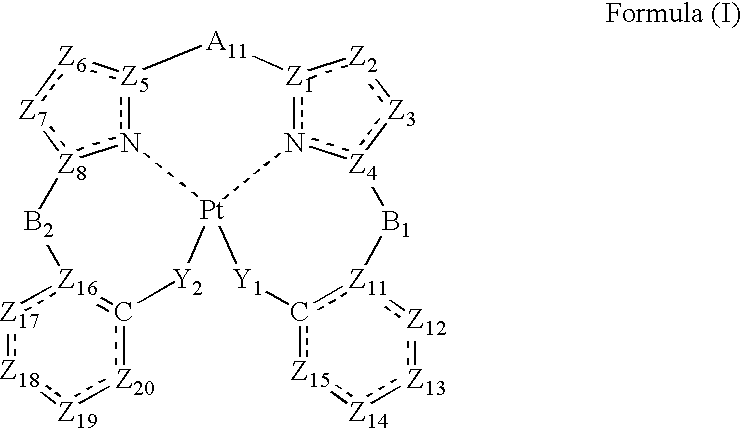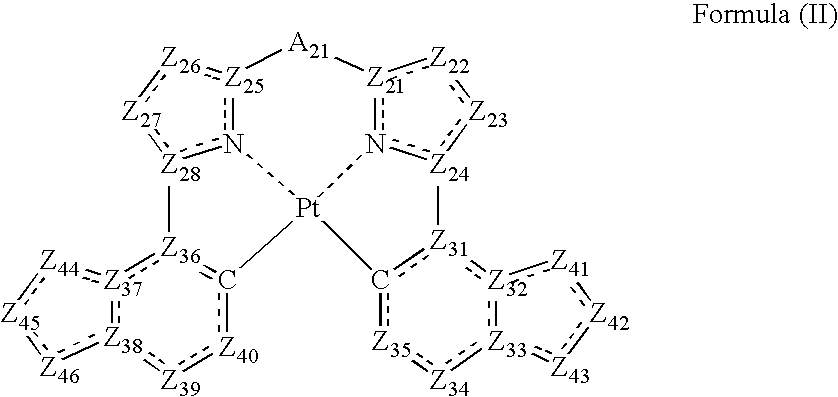Organic electroluminescence device
a technology of electroluminescence device and complex compound, which is applied in the direction of luminescence screen of discharge tube, platinum organic compound, organic chemistry, etc., can solve the problems of insufficient devices, insufficient luminescence quantum efficiency, and inability to meet the requirements of high efficiency and high durability. achieve good light emission properties (emission wavelength, luminance, quantum yield, driving voltage) and durability
- Summary
- Abstract
- Description
- Claims
- Application Information
AI Technical Summary
Benefits of technology
Problems solved by technology
Method used
Image
Examples
example 1
[0239]In a similar manner to Comparative Example 1 except for the use of Compound (31) of the invention (emission wavelength: 480 nm) instead of Comparative compound 1, an organic EL device of Example 1 is fabricated. When a DC constant voltage (7V) is applied to the organic EL device thus fabricated, bluish green light emission is observed. At the same luminance, the voltage of the organic EL device of Example 1 is 0.95 time of that of Comparative Example 1, 0.9 time of that of Comparative Example 2, and 0.89 time of that of Comparative Example 3. The external quantum efficiency of the organic EL device of Example 1 is 1.2 times of that of Comparative Example 1, 1.5 times of that of Comparative Example 2, and 1.2 times of that of Comparative Example 3. The luminance half-life of each of the organic electroluminescence devices thus obtained is determined by setting the device in “OLED Test System Model ST-D” manufactured by Tokyo Systems Development and driving it in a constant curr...
example 2
[0240]In a similar manner to Comparative Example 1 except for the use of Compound (20) of the invention (emission wavelength: 445 nm) instead of Comparative Compound 1, an organic EL device of Example 2 is fabricated. When a DC constant voltage (7V) is applied to the organic EL device thus fabricated, blue light emission is observed. At the same luminance, the voltage of the organic EL device of Example 1 is 0.95 time that of Comparative Example 1, 0.9 time of that of Comparative Example 2, and 0.89 time of that of Comparative Example 3. The external quantum efficiency of the organic EL device of Example 2 is 1.1 times that of Comparative Example 1, 1.4 times that of Comparative Example 2 and 1.2 times of that of Comparative Example 3. The luminance half-life of the organic electroluminescence device thus obtained is determined by setting the device in “OLED Test System Model ST-D” manufactured by Tokyo Systems Development and driving it in a constant current mode under the conditio...
PUM
| Property | Measurement | Unit |
|---|---|---|
| thickness | aaaaa | aaaaa |
| thickness | aaaaa | aaaaa |
| transmittance | aaaaa | aaaaa |
Abstract
Description
Claims
Application Information
 Login to View More
Login to View More - Generate Ideas
- Intellectual Property
- Life Sciences
- Materials
- Tech Scout
- Unparalleled Data Quality
- Higher Quality Content
- 60% Fewer Hallucinations
Browse by: Latest US Patents, China's latest patents, Technical Efficacy Thesaurus, Application Domain, Technology Topic, Popular Technical Reports.
© 2025 PatSnap. All rights reserved.Legal|Privacy policy|Modern Slavery Act Transparency Statement|Sitemap|About US| Contact US: help@patsnap.com



